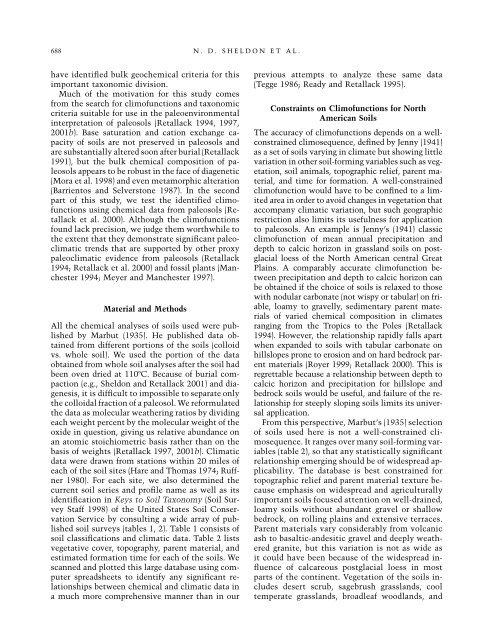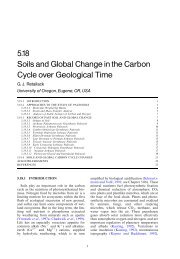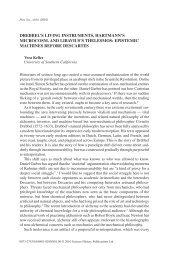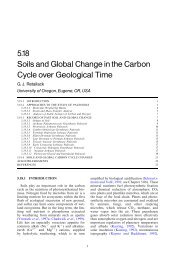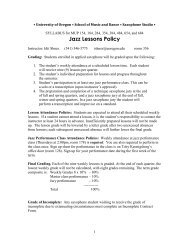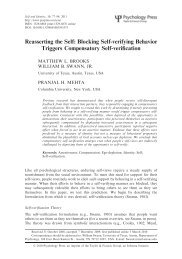Geochemical Climofunctions from North American Soils and ...
Geochemical Climofunctions from North American Soils and ...
Geochemical Climofunctions from North American Soils and ...
- No tags were found...
Create successful ePaper yourself
Turn your PDF publications into a flip-book with our unique Google optimized e-Paper software.
688 N. D. SHELDON ET AL.have identified bulk geochemical criteria for thisimportant taxonomic division.Much of the motivation for this study comes<strong>from</strong> the search for climofunctions <strong>and</strong> taxonomiccriteria suitable for use in the paleoenvironmentalinterpretation of paleosols (Retallack 1994, 1997,2001b). Base saturation <strong>and</strong> cation exchange capacityof soils are not preserved in paleosols <strong>and</strong>are substantially altered soon after burial (Retallack1991), but the bulk chemical composition of paleosolsappears to be robust in the face of diagenetic(Mora et al. 1998) <strong>and</strong> even metamorphic alteration(Barrientos <strong>and</strong> Selverstone 1987). In the secondpart of this study, we test the identified climofunctionsusing chemical data <strong>from</strong> paleosols (Retallacket al. 2000). Although the climofunctionsfound lack precision, we judge them worthwhile tothe extent that they demonstrate significant paleoclimatictrends that are supported by other proxypaleoclimatic evidence <strong>from</strong> paleosols (Retallack1994; Retallack et al. 2000) <strong>and</strong> fossil plants (Manchester1994; Meyer <strong>and</strong> Manchester 1997).Material <strong>and</strong> MethodsAll the chemical analyses of soils used were publishedby Marbut (1935). He published data obtained<strong>from</strong> different portions of the soils (colloidvs. whole soil). We used the portion of the dataobtained <strong>from</strong> whole soil analyses after the soil hadbeen oven dried at 110C. Because of burial compaction(e.g., Sheldon <strong>and</strong> Retallack 2001) <strong>and</strong> diagenesis,it is difficult to impossible to separate onlythe colloidal fraction of a paleosol. We reformulatedthe data as molecular weathering ratios by dividingeach weight percent by the molecular weight of theoxide in question, giving us relative abundance onan atomic stoichiometric basis rather than on thebasis of weights (Retallack 1997, 2001b). Climaticdata were drawn <strong>from</strong> stations within 20 miles ofeach of the soil sites (Hare <strong>and</strong> Thomas 1974; Ruffner1980). For each site, we also determined thecurrent soil series <strong>and</strong> profile name as well as itsidentification in Keys to Soil Taxonomy (Soil SurveyStaff 1998) of the United States Soil ConservationService by consulting a wide array of publishedsoil surveys (tables 1, 2). Table 1 consists ofsoil classifications <strong>and</strong> climatic data. Table 2 listsvegetative cover, topography, parent material, <strong>and</strong>estimated formation time for each of the soils. Wescanned <strong>and</strong> plotted this large database using computerspreadsheets to identify any significant relationshipsbetween chemical <strong>and</strong> climatic data ina much more comprehensive manner than in ourprevious attempts to analyze these same data(Tegge 1986; Ready <strong>and</strong> Retallack 1995).Constraints on <strong>Climofunctions</strong> for <strong>North</strong><strong>American</strong> <strong>Soils</strong>The accuracy of climofunctions depends on a wellconstrainedclimosequence, defined by Jenny (1941)as a set of soils varying in climate but showing littlevariation in other soil-forming variables such as vegetation,soil animals, topographic relief, parent material,<strong>and</strong> time for formation. A well-constrainedclimofunction would have to be confined to a limitedarea in order to avoid changes in vegetation thataccompany climatic variation, but such geographicrestriction also limits its usefulness for applicationto paleosols. An example is Jenny’s (1941) classicclimofunction of mean annual precipitation <strong>and</strong>depth to calcic horizon in grassl<strong>and</strong> soils on postglacialloess of the <strong>North</strong> <strong>American</strong> central GreatPlains. A comparably accurate climofunction betweenprecipitation <strong>and</strong> depth to calcic horizon canbe obtained if the choice of soils is relaxed to thosewith nodular carbonate (not wispy or tabular) on friable,loamy to gravelly, sedimentary parent materialsof varied chemical composition in climatesranging <strong>from</strong> the Tropics to the Poles (Retallack1994). However, the relationship rapidly falls apartwhen exp<strong>and</strong>ed to soils with tabular carbonate onhillslopes prone to erosion <strong>and</strong> on hard bedrock parentmaterials (Royer 1999; Retallack 2000). This isregrettable because a relationship between depth tocalcic horizon <strong>and</strong> precipitation for hillslope <strong>and</strong>bedrock soils would be useful, <strong>and</strong> failure of the relationshipfor steeply sloping soils limits its universalapplication.From this perspective, Marbut’s (1935) selectionof soils used here is not a well-constrained climosequence.It ranges over many soil-forming variables(table 2), so that any statistically significantrelationship emerging should be of widespread applicability.The database is best constrained fortopographic relief <strong>and</strong> parent material texture becauseemphasis on widespread <strong>and</strong> agriculturallyimportant soils focused attention on well-drained,loamy soils without abundant gravel or shallowbedrock, on rolling plains <strong>and</strong> extensive terraces.Parent materials vary considerably <strong>from</strong> volcanicash to basaltic-<strong>and</strong>esitic gravel <strong>and</strong> deeply weatheredgranite, but this variation is not as wide asit could have been because of the widespread influenceof calcareous postglacial loess in mostparts of the continent. Vegetation of the soils includesdesert scrub, sagebrush grassl<strong>and</strong>s, cooltemperate grassl<strong>and</strong>s, broadleaf woodl<strong>and</strong>s, <strong>and</strong>


